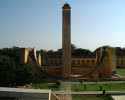The centrepoint of Jaipur is the Palace of the Winds, a huge facade that allowed the ladies of the town to observe the processions through the streets without their faces being seen. At the time, neither the Moslem nor the Hindu women were allowed to show their faces.
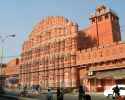
A courtyard of the Amber Fort, north of Jaipur. The fort existed before the city of Jaipur; it was only after 150 years after the fort was built that it was considered safe to move out of the fort and build a town on the plains nearby.
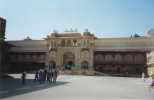
The gardens were kept up; at some other forts they looked pretty sad.
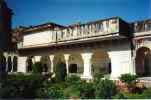
A view from the fort of the festival occurring in the village below.
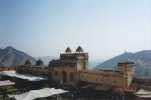
A domed enclave from where the maharaja could see the peaceful village below. (Or the invading hordes, depending on the times.)
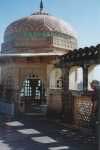
One of the options for getting up to the fort was an elephant ride. Unfortunately, when we were there the elephants were on holiday too.
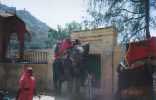
Jean in front of one of the decorative archways.
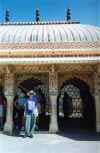
Monkeys abounded in rural India, and they were plentiful at the Amber fort. They were almost as cute as the squirrels.
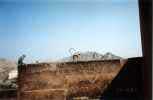
In Jaipur we went to a "authentic village festival", which was mainly an exercise in extracting money from tourists. However the meal was excellent. In order: Nicole, Peter and Jean.
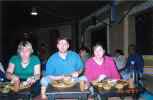
On entry, everybody was marked on the forehead with "red stuff" and rice.

Everybody loved the squirrels in India; stripy bodies, cute furry tails. The locals didn't notice them, but sometimes we tourists would pay more attention to the squirrels than whatever we were being shown. In this case I was in the City Palace Museum in Jaipur. About the time I took this shot, a bird crapped on my head.
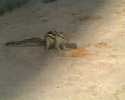
Maharaja Jai Singh II, founder of Jaipur, was very into astronomy, and he commissioned 5 observatories around India. This one in Jaipur is the best preserved.
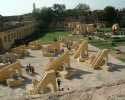
This was all before telescopes of course. The sun's position could be easily determined by casting the shadow of the intersection of two wires onto the labelled rock surface. For the planets, the astronomer could walk under the inverted dome and sight the planet manually.
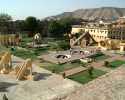
The time is read from the edge of shadow of the central column (which has steps up the back so you can walk 30m to the top). All the stone is perfectly set for the latitude of the observatory.
